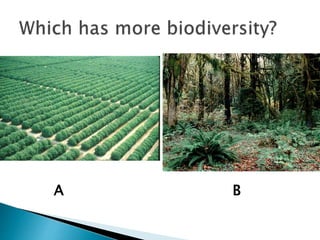Biodiversity
- 1. SUBMITTED BY : VAISHALI JAIN MSC (TECH) ENVIRONMENTAL SCIENCES AND TECHNOLOGY SEMESTER -1
- 2. Bio = Biodiversity What does “Bio” means?
- 3. Biodiversity Diversity = Variety What does “Diversity” means?
- 4. BIODIVERSITY or BIOLOGICAL DIVERSITY is the variety of the earth’s species , the genes they contain , the ecosystem in which they live and the ecosystem processes such as energy flow and nutrient cycling that sustain all life .
- 5. Biodiversity exists on several levels: Genetic diversity Species diversity Ecosystem diversity Figure 15.2
- 6. A SPECIES is a group of organisms capable of interbreeding and produce fertile offspring. SPECIES DIVERSITY is the number and abundance of species present in different communities. It mainly consists of two components: Species richness and Species eveness
- 7. GENETIC DIVERSITY is the variety of genetic material within a species or a population. The Genetic Makeup of a population through successive generations is due to : Genetic Variability Mutations - random changes in DNA Natural selection Adaptations Differential reproduction Genetic resistance
- 8. ECOSYSTEM DIVESITY is the variety of different types of ecosystems such as terrestrial and aquatic ecosystems found in an area or on the earth. It can be describes for a specific geographical region or a political entity such as country or state. A region may have several ecosytems or it can have only one ecosystem. For example: DESERTS AND OCEANS having low ecological diversity while MOUNTAIN AREA that has lakes, forests, grasslands would have high ecological diversity.
- 9. PLZZZZ …. DON’T RUN ,,, DON’T GET SCARED …. :P
- 10. A B
- 11. A B
- 12. A B
- 13. A B Which is more diverse?
- 14. Which has more biodiversity? A B
- 15. A B
- 16. Have you all ever thought WHY THIS MUCH OF BIODIVERSITY IS ESSENTIAL? WHY cant we all human beings live alone on this planet earth? Why should we care about any other species? How our fate is connected to “DIVERSITY” ? The most important question “who cares for biodiversity” ?
- 17. Consumptive value: Food/Drink Fuel Medicine Better crop varieties Industrial Material Non-Consumptive Value: Recreation Education and Research Traditional value Ecological services: Balance of nature Biological productivity Regulation of climate Degradation of waste Cleaning of air and water Cycling of nutrients Control of potential pest and disease causing species Detoxification of soil and sediments Stabilization of land against erosion Carbon sequestration and global climate change Maintenance of Soil fertility
- 19. •With only 2.4 % of the world’s area, India accounts for 7–8 % of the world’s recorded plant and animal species. • India’s ten biogeographic zones possess an exemplary diversity of ecological habitats like alpine forests, grasslands, wetlands, coastal and marine ecosystems, and desert ecosystems. •HENCE , we can conclude that INDIA HAS LARGE SPECIES AS WELL AS ECOSYSTEM DIVERSITY.
- 21. HOTSPOT-A region with high biodiversity with most of spices being Endemic. India have three Biodiversity Hotspots- East Himalayan Region, Western Ghats and India-Burma Region.
- 22. Natural causes: Narrow geographical area Low population Low breeding rate Natural disasters Anthropogenic causes: Habitat modification Overexploitation of selected species Innovation by exotic species. Pollution Hunting Global warming and climate change Agriculture
- 23. Conserving Biodiversity in protected Habitats- In situ conservation – WILDLIFE SANCTUARIES, NATIONAL PARKS Ex situ conservation – ZOO, BOTANICAL GARDENS Seed Bank, Gene Bank, Pollen Bank, DNA Bank























